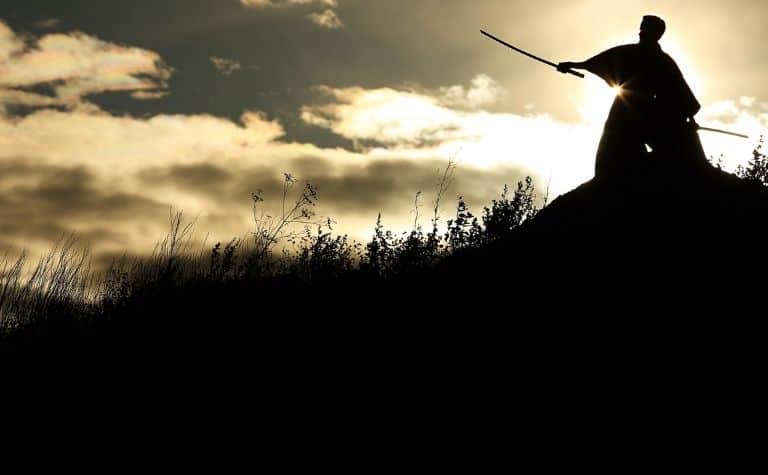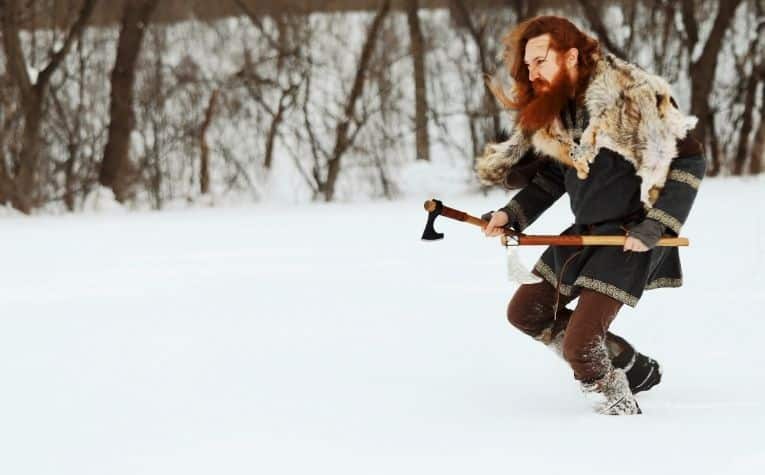History is full of memorable people and cultures whose legacies have withstood the passing of time.
Centuries after their respective reigns ended, the Vikings and Samurai are widely recognized as two of the most decorated and accomplished military societies.
In terms of individual swordsmanship, the Samurai had elite skills.
However, during their heyday, the Vikings, as a fighting force, vanquished Medieval Europe’s finest armies and settled many of their people on foreign soil.
By the slimmest of margins, the edge goes to the Vikings over the Samurai.
The Vikings and Samurai are popular figures in modern pop culture, which is a testament to their legendary achievements.
Pitting them against each other in a mythical battle is an exercise in pure conjecture, and in this challenge, the Vikings get the slight nod for the reason that has nothing to do with their weapons or superior size.
Keep reading to learn why.
Also see Did Viking Helmets Really Have Horns? to learn more.

Physical Stature: Vikings vs Samurai
The Vikings and the Samurai were such larger-than-life figures that the line between myth and reality was often blurred regarding their exploits.
As their fame and infamy grew, so too did their respective legends.
And both were the beneficiaries of fearsome reputations that oftentimes had their enemies quaking with fear before actual face-to-face confrontations took place.
How big were the Vikings? What did they look like? The common image of a Viking warrior depicts a towering, muscular, gladiator-like figure with a scraggly beard and long, flowing blond hair, clutching a magnificent sword in one hand and a massive shield in the other.
Indeed, a third-party account provided by an Arabic emissary named Ibn Fadlan describes his encounter with the Rus (Swedish Vikings who made their way east) in Russia:
“I have never seen more perfect physical specimens, tall as date palms, blonde and ruddy… Each man has an axe, a sword, and a knife and keeps each by him at all times.” [1]
emphasis added
By analyzing the skeletal remains recovered from Viking burial sites throughout Scandinavia and beyond, scientists have been able to determine the physical stature of these legendary Norse warriors, and their findings are somewhat surprising. [2] (Also see Were the Vikings Tall?)
- Using the femur (thighbone) as a baseline measurement, a person’s height can be extrapolated from its length by a factor of roughly 4x
- Based on a recent study, the average height of Vikings is estimated to have been between 5’8” and 5’9” (173.4 cm), which is roughly the same height as the average male living in the Western world today
- The Vikings were taller than their European counterparts during the Middle Ages and but would certainly not stand out in a crowd in modern times (Also see What Did the Vikings Look Like?)
Also see The Seax: A Powerful Viking Weapon to learn more.

How big were the samurai? What did they look like? When bedecked in their full armor and battle regalia, Japanese Samurai were an intimidating sight with an almost other-worldly appearance.
However, the Samurai’s battle dress made them appear larger and taller in full gear than they actually were.
The average Samurai was 5’3” to 5’5” (155 cm) tall and typically had a slender build. [3]
There were certainly exceptions. For instance, famed samurai Musashi Miyamoto (1584 – 1645) was nearly six feet tall. [4] But most Samurai were relatively slight in physical stature.
This would have made these Japanese warriors several inches shorter, on average, than their Norse counterparts, who stood around 5’8”.
In a boxing ring or MMA octagon, this difference might be substantial.
Still, when armed with swords and spears or when fighting on horseback, the difference in stature would not seem to be a significant factor in the outcome of a full-fledged battle between these two formidable forces.
Unless, of course, Vikings and Samurai ditched their weapons and engaged in hand-to-hand fighting. (Also see Did the Vikings Ever Fight the Samurai?)
Also see Where Was the TV Show Vikings Filmed to learn more.
Viking Weapons vs. Samurai Weapons
Two of the greatest warrior societies history has ever seen owe their conquests to their indomitable spirit and unmatched courage.
The Vikings and Samurai are also closely associated with their own unique brands of weaponry that perfectly suited their respective fighting styles.
In Europe during the Middle Ages, weapons were fashioned from readily available materials.
In the case of the Vikings, only chieftains and warriors with means would have been able to afford swords which at the time were fashioned from iron, a very expensive resource and material that required great skill (and thus, adding to their cost) to work into a blade. [5]
For the typical Viking warrior, commonly used weapons and armament included:
- Axes were perhaps the most popular weapon for the common Viking warrior due to their affordability and effectiveness (even farm axes would suffice in battle)
- Daggers were well-suited for hand-to-hand combat
- Spears with long shafts were ideal for thrusting toward enemies
- Bows and arrows were also commonly used by Viking forces
- Shields were indispensable and were often mandated to be carried by Viking warriors
- Chainmail was worn, but like swords, was only used by those who could afford them [6] (Also see Did the Vikings Wear Chainmail?)
The Samurai rose to power in feudal Japan in earnest, beginning in the 12th century, which was shortly after the Viking Age had come to an end in Medieval Europe.
Japanese craftsmen were highly skilled at metalworking, and steel was the material of choice. Samurai weaponry included the following:
- Elite Samurai were known to carry two swords of varying lengths: the katana was a magnificent curved sword with a blade measuring around two feet long (60 cm), and the wakizashi was a shorter weapon with a 12-inch blade (30 cm)
- Ordinary Samurai (infantrymen) carried spears and polearms
- Samurai were skilled archers and could use bows and arrows proficiently while on horseback
- Elaborate armor fashioned from pieces of metal (typically bronze or iron) and leather strips are often closely associated with the Samurai, along with their distinctive helmets [7]
The Japanese mastered the art of sword-making, and many scholars believe that the samurai katanas were among the world’s sharpest and finest-made blades during the entire Medieval period.
In terms of weaponry, particularly swords, the edge (no pun intended) goes to the Samurai.
The Vikings were Used to Fighting in Hostile Lands
During the Viking Age, the reputation of the Norsemen as raiders, plunderers, and conquerors grew and spread with each successful raid.
The fact that Viking conquests occurred away, and oftentimes quite far, from their native lands, in Scandinavia, demonstrates their unique ability to adapt to fighting on foreign soil against enemy forces who were defending their homelands against the Norse invaders. (Also see 6 Reasons Why the Vikings Invaded Britain)
To put it simply, the Vikings were unafraid of taking the fight to their enemy, even if it meant losing home-field advantage.
Their stealthy ways meant that they could launch surprise attacks, and their uncanny ability to quickly adjust their combat techniques to suit their surroundings was perhaps one of their most feared attributes.
No land within reach of the Viking longships was safe from invasion.
The list of foreign lands conquered by the Vikings (many of which were eventually settled by the Vikings as well) is extensive and impressive:
- England (Northumbria, East Anglia, Mercia, York, Wessex)
- Faroe Islands
- France (Normandy)
- Ireland
- Isle of Man
- Orkney Islands
- Scotland [8]
While the Vikings infamously raided defenseless targets like monasteries, they also vanquished formidable armies, particularly during their invasions of England.
In a hypothetical battle between Vikings and Samurai, the Norse warriors’ proven ability to take the battle to the enemy and defeat them on their own native soil gives the edge to the Vikings by the slimmest of margins.
Hardened and battle-tested by the best opposition that Medieval Europe could muster, the Vikings would overcome their Japanese adversaries but limp home wounded and bloodied with decimated ranks.
Did the Vikings Ever Invade Japan?
The Vikings were feared throughout Northern Europe because of their ruthless and bloody ways and their uncanny ability to transport their mighty warriors over great distances to fight battles in distant lands.
As far as known Viking military campaigns are concerned, there is no record that they ever ventured beyond Europe. Viking conquests in Northern Europe are well documented.
It is believed that they even conquered parts of Italy and areas along the Mediterranean coast. [9]
Still, as far as Viking invasions of Japan are concerned, neither European nor Japanese historical records make a single mention of such an event.
Time itself conspired against any encounter between the Vikings and Samurai, military or otherwise.
The widely accepted end of the Viking Age is the mid-11th century [10], while the rise to power of the Samurai in Japan did not occur until the 12th century. [11] (Also see The Viking Shield: The Meaning of the Shape, Color, and Patterns)
Did Vikings Ever go to Asia?
The Viking thirst for conquest was equaled only (or perhaps motivated) by their desire for wealth and financial security.
It was likely this quest for riches that drew the Vikings eastward from Scandinavia, sailing along major European rivers and tributaries to the Caspian Sea.
From there, the Norsemen traveled over land (likely by camel) to Baghdad (Iraq) and Constantinople (Istanbul, Turkey). [12]
While the Vikings traversed an incredible distance of over 3,000 miles from their Scandinavian homeland to pursue riches in what is now known as the Middle East, it appears from all historical accounts that this is the furthest east they traveled.
In other words, the Vikings never made it to Asia proper.
The Vikings and Samurai were separated by thousands of miles and hundreds of years but inexorably linked by a common warrior spirit.
References:
[1] Source
[2] Source
[3] Source
[4] Source
[5] Source
[6] Source
[7] Source
[8] Source
[9] Source
[10] Source
[11] Source
[12] Source
